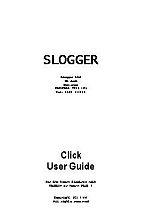
Beebug
 1st May 1990
1st May 1990
Categories: Review: Peripheral
Author: Jonathan W. Wilkinson
Publisher: Slogger
Machine: Acorn Electron
Published in Beebug Volume 9 Number 1
With the press of a button, Slogger's Click! offers a host of DFS and ADFS utilities, a memorandum system and more for users of the BBC Master 128. Jonathan W. Wilkinson 'presses' it into action.
Click! (Slogger)
Following some nine months of silence, Slogger have reappeared after their office move, and brought out Click. Supplied in a standard issue Acorn ROM cartridge, containing 32Kbytes of ROM, 8Kbytes of static RAM (with necessary battery-backup), and a switch on the top to activate it, CLICK offers a host of utilities.
When pressing the little black button on the top of the cartridge, teletext mode 7 is entered to present a menu screen. Once the appropriate facility has been used, the computer is restored to exactly what it was doing before (cf PMS's Genie).
The following facilities are offered: Memo, ADFS, DFS, Memory Editor and System. The required option and its sub-menus, if any, is selected by using the cursor keys to highlight the one desired, with Return to confirm.
The Memo facility is probably the most desirable facility offered. It enables various appointments to be entered, along with their date and time. At the appropriate time, CLICK activates itself and displays the message. This leaves very little excuse for missing important meetings, or events, etc. (assuming one does not forget to enter the data in the first place).
A series of utilities for use with the Advanced Disc Filing System (ADFS) is provided, namely: Format, Verify, Sector editor, and Extree. The first three need no explanation; the last, however, requires some discussion. It provides a front-end system for manoeuvring around the ADFS's hierarchical structure: the top of the screen displays, in a scrolling window format, the position of the current directory in relation to others; the centre shows the full pathname of the current directory; and the lower section the files in it. It is possible to move around the directories, and to change the attributes of any files. One slight problem encountered was that if the path name of the current directory exceeds about thirty-eight characters, the display becomes corrupt. DOS users may note the similarity of the Extree facility with the front-end systems provided by Directory Assistance, PC-Tools, etc.
A similar set of utilities is also provided for use with the Disc Filing System (DFS), save for Extree. The Memory editor is a run-of-the-mill memory examiner, displaying the contents in both hexadecimal and ASCII formats. It is rather slow at scrolling through memory.
The final set of utilities is provided under the System menu and includes: mouse handler, CMOS clock-setting, and printer dump. The last one enables various parameters to be set, so that screens can be printed out by pressing shift in combination with the little black button.
Although Click offers a reasonable set of utilities, it doesn't really offer anything to shout loudly about. The use of teletext mode 7 is quite a limitation to the screen formats, which are rather plain. If one is after a set of utilities for use with DFS and ADFS, and an appointment system, a combination of ACP's Advanced Disc Toolkit (ADT) and PMS's Genie would be better suited. In all, a nice product, had it been offered a year or two ago, but already looking outdated at its launch.


